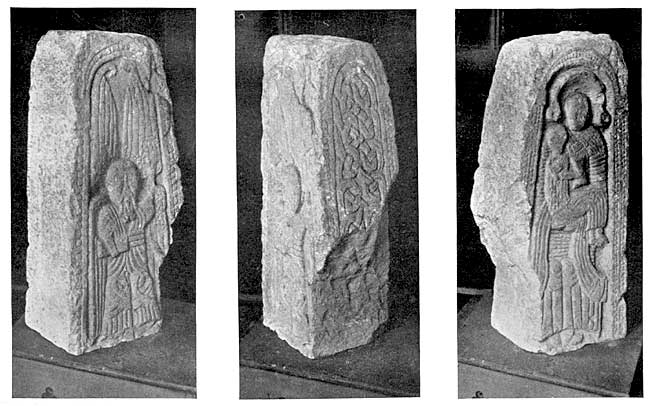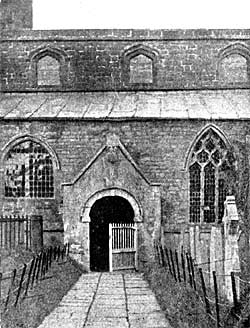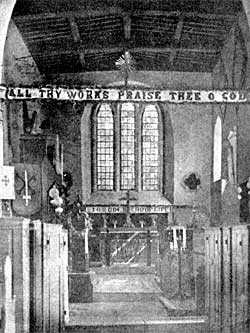
Fragments of pre-Norman cross, Shelford Church.
You will notice, that Mr. Christian in his restoration got rid of the former three-light window, on the south side of the chancel and went in symmetrically for four lancet windows, all deeply splayed internally, on either side of the chancel. The old photographs, I have secured, do not show this part of the fabric, but prior to 1877, the chancel door stood somewhat west of its present position and there was a low-side window to the right of it, which was restored out of existence by the contractor. But, built up in a brick buttress formerly supporting this south aisle, was found a fine piece of the shaft of a stone cross. This was fortunately preserved, and is now to be seen on the cill of the east window of the south aisle. The cross was undoubtedly old; and dated from preNorman times.

South-west porch, Shelford church. Prior to 1877.

Chancel, Shelford church. Prior to 1877.
The next point of interest is the south-west porch. The present porch is nineteenth century work. It took the place of an earlier porch, shewn in one of the photographs with a closed gate; and having an angel in the gable, supporting a plain shield and corbel, with a lozenge-shaped table underneath, and the date 1587.
Mr. Stretton describes this porch as having” side benches of stone but no waterstock,” and also says that there are “protection stones from the shingled roof” to a still older porch. The angel and shield formerly in this gable may now be seen within the church, built into the north arcade wall of the nave, at its west end.
Before entering the church let us note that the clerestory is of considerably later date than other parts of the original church. It contains four two-light windows on each side, all of which have the depressed Tudor arch.
With respect to the roofing,—it was all flat and leaded prior to the restoration; but this lead roofing had displaced a shingled roofing, which was distinctly high-pitched in the case of the chancel. Mr. Ellis's photograph indicates this; and Mr. Stretton notices the water-tabling attached to the tower as indicating the original material of the roofing.
Coming to the interior of the church, we have first of all, a late font bearing the date 1662. There are several of the same type in the neighbourhood, viz:—at East Bridgford, Whatton, Scarrington, and Sibthorpe. This fact points I think, to the exceptional destruction of fonts in this neighbourhood during the Civil War.
The tower archway is a very fine one, and as shewn by its mouldings is of the late Decorated period. If we mount the tower staircase, we shall find in the ringing-chamber a few items of interest besides the old stone striking hammer. On the walls are the following:—
| I and P. Clark 1826. | |
| N. | N. |
| C. + Face 1837 | C. + Rope 1836 |
The initials N. C. stand for new clock.
The belfry is first of all interesting as having the older method of securing the bells to the bell-frame with cotters, as well as the later one of using iron nuts.
The inscriptions on the bells are as follows:—
| (1) | In Roman capitals. God save His church, Sir Wil Stanhope 1702, Geo. Raynor. |
| (2) | In plain old Lombardic. Ave : Maria : GRA : plena : DNS : tecum. |
| (3) | +GOD SAVE HIS CHVRCH 1592 [3] |
| (4) | IOHN COWPER HENRY ELLIS CHURCHWARDENS 1754, THOS. HEDDERLEY Founder. |
| And in Old English | |
| (5) | Celorum xte placeat tibi rex sonus iste. |
This bell No. 5 on which the hours are struck, weighs 1 ton 19¾cwts.
The arcading of the nave, which is of three bays, is somewhat late Early English; the pillars are octagonal and the mouldings of their bases and capitals are almost indentical in profile with E.E. examples given by Paley. A good deal of restoration has taken place, more especially on the north arcade.
The two blocks of stone jutting out from the walls of the nave, just above the capitals of the columns of the chancel arch are somewhat remarkable, and perhaps carried uprights for the old low roofing; more probably perhaps the cancclli, which Mr, Stretton speaks of, as being taken down in his day except a part within the arch which bore the arms of King George I. But as a matter of fact these stones seem placed too low for the roofing and too high for the cancelli.
In 1818, and down to the restoration of 1877, the old tombs and monuments described in Thoroton remained in the chancel. At the restoration of the church all these monuments were transferred to the east-end of the south nave and enctosed within the screen we now see, which was made, as was also the pulpit, from the timbers of the old roof. An aumbrey existed on the north side of the sanctuary and a piscina on the south. Mr. Stretton speaks of both these; and the latter in 1818 was bricked. The builder at the restoration seems to have ruthlessly done away with them.
The stained glass windows in the present chancel are modern ones by Kemp, and are beautiful examples of his work.
Altar-table, choir stalls, nave seats, the eagle, and the west screen, are all quite modern. But the alms-box near the south-west door is old; possesses two locks, which one key opens. It is altogether a quaint and curious example of its kind.
The church plate is modern, but a remarkable story attaches to the silver paten now in use. A certain Colonel Tibbs, serving in the Peninsula war, married a Spanish lady named Pereira, whose brother was a brother in the convent of barefooted friars at Busaco. The sacred vessels of this convent were looted by the officers, melted down and made into silver spoons. In this shape some of the looted silver came into the hands of Colonel Tibbs, and was inherited by his son Henry Wallis Tibbs, some years ago curate-in-charge of this parish. Mr.Tibbs, who on inheriting property from his mother, took the name Pereira, would never use these spoons and finally made a present of them to Mr. Henry Ellis, who in lieu of them bought a set of four stoles for Shelford church. But Mr. Ellis was not satisfied nnd still had scruples about using these silver spoons. They were melted down again and made into a cross, for private use. But, as Mr. Ellis remained unsatisfied, the cross in its turn was melted down, and made into a paten for sacred use at the altar of this church of St. Peter and St. Paul. The silver was thus restored to its primary purpose.
It now remains for us to deal with the monuments of the Stanhope family, removed in 1877-8 to the east end of the south aisle and enclosed in the screen made of wood from the old roof.
A black slab on the wall below the east window of the south aisle, has the following inscription in quaint letters and curious spelling:—
"The Epitaphe of Sir Michaell Stanhope knight whilest he lyved governor of Hull under the la/te kinge of Famous memorie Henre theighte and cheife gentleman of pry vie chamber to the la/te noble and good kinge, Edward the sixt. by Sir Michaell she had theis Children Sr Thom/as Stanhope of Shellford in the Countie of nottingham knight Elenor maried to thomas/ Cowper of thurgorton in the countie of nott esquier Edward Stanhope esquier one of her / magesties Counsell in the northe partes of England lulyon maried to Iohn Hotham of / Scorborowe in the Coutie of yorke esquier Ioh Stanhope esquier one of the gentlemen / of the pryvie chamber to our most deare Sovarigne ladie queene Elizabeth lane ma/ryed to Sr roger towneshende of rayham in the Countie of norfolke knight Edwarde / Stanhop doctor of the civell lawe one of the masters of her magesties heigh courte of / Chancerie Michaell Stanhope esquier one of the pryvie Chamber to Queene El/yzabeth Besides margaret wyllm and edwarde who dyed in their infancie the /said ladie ann Stanhope lyvede widowe xxxv yeares in woh tyme she broug/ht up all her yonger children in vertue and learninge whereby they weare / preferred to the maridge and callinge before recyted in her lyfe tyme she kept / Contynewallie a worshipful! house releved the poore dealy gave good Coutena/nce and conforte to the preachers of gods word spent the most tyme of her / latter dayes in prayer and usinge the church where gods word was preached/she beige .... yeares old dyed the XXth of februarie 1587 the xxx yeare of / the Queenes Raigne aforsayd in the faith of Christ wth hope of a loyfull Resurreccio."
(1) On the brass elegantiarnem appears as a misprint for elegantiarum.
